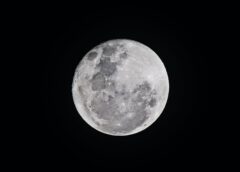The most powerful and brightest rocket to ever be launched by humanity lifted itself above the swamps of East Florida. It was the first launch of many missions dubbed: Artemis. This mission is dedicated to lighting a spark in the deep darkness of space by sustaining a constant presence on our only large natural satellite: The Moon.
On Wednesday the 16th of November, at 6:47am the Orion capsule set off aboard the SLS (Space Launch System) and into a Low Earth orbit. Once it achieved this, the second stage of the rocket burned its engine to raise its orbit higher above the Earth. Once the capsule has come back down to its perigee (lowest point in the orbit), it will once again burn its engine to raise its orbit into an encounter with the moon. It will then lower its velocity to have a close flyby. It will not enter an orbit but burn itself back into an encounter with Earth’s atmosphere. Then it will separate its service module from its capsule and re-enter the Earths atmosphere.
Along the way to the moon and back, the team at NASA will test many different digital and life support systems aboard the Orion spacecraft. This will enhance NASA’s knowledge on what needs to be fixed or improved inside the craft and make it as safe as possible for future astronauts.
Sarah Cruddas, leading space journalist and author, was present at the launch of Artemis, said: “We are returning to the moon. Soon you will be able to look up at the moon and know there are people there – possibly looking back at you. Here’s to a new era in space exploration. The Artemis Generation.”
Despite this impressive first launch, NASA have had much trouble in launching this rocket. Failing to achieve its original launch date, 2017, the SLS rocket has suffered many setbacks due to weather and technical issues. In August 2022 a hydrogen leak in the second stage engine forced them to ‘scrub’ the mission and roll it back to the VAB (Vehicle Assembly Building). A few weeks prior to the actual launch, hurricane Ian struck the East coast of Florida and the Kennedy space centre. Despite this, NASA kept the rocket out and it only suffered minor damage which, was easily fixed.
“We rise together, back to the moon the moon and beyond,” echoing the words of Derrol Nail, who is the official NASA commentator. But will NASA reach its colonization goal before its too late for the earth? Will we fulfil the dreams of John F. Kennedy or quench them in failure yet again? This is all up to you, to decide the destiny of our race.
By Max, Austin & Owen Yr8
Carre’s Grammar School, Sleaford

Wow, this sounds very exciting! It is good that the rocket could finally launch.
In early December it will be the 50th anniversary of when humans last went to the moon. Crazy to think how that was achieved with the basic technology they had back then – not many had colour tv and only three channels. Sending probes and robots would be much cheaper.
A well researched and written article.
An excellent and informative piece of writing. I love space and everything to do with it. Well done boys.
What an interesting article to read I will be sure to ask my relatives about it who back on to Cape Canaveral. Will you be doing updates?
Nice love it🔥🥰🥰🔥
Amazing article boys love it keep it up
Nice one Austin and Max, very interesting!
Very interesting
Love it!!
Nice
This is so good guys. Well done! Keep up the good work
A very interesting and informative article. I enjoyed reading it.
Very good love the information!
These kids are going places!!!
This article is really good, can’t wait for the next Artemis launch!
Love too hear more about nasa and all the other space organisations. 😁
Keep up the good work.
Max, Owen and Austin, this is just brilliant! Bright futures ahead of you. In the words of Derrol Neil ‘“We rise together, back to the moon the moon and beyond,”… tocuhe Mr Neil. You three are certainly rising together!
Brilliantly written and interesting article 👏
Impressively written boys – well done!
Very interesting article – well done.
A very interesting read! Well done 🙂
Very detailed and interesting especially for a person who likes astronomy like me. Great work!
how viable do you think this project is given the economic climate around the world at the moment?
Nice article! Very wild to think that we went to the moon only 66 years after inventing the plane (1903/1969). In 2035 another 66 years will have passed since then, I wonder what thing we’ll have doing then we once thought of as impossible? Looking forward to my Lunar holiday home.
Great article and it seems Artemis is breaking records! Looking forward to more update?
https://www.theverge.com/2022/11/29/23484571/artemis-1-halfway-record-distance
Great read, seems you Artemis is breaking records! https://www.theverge.com/2022/11/29/23484571/artemis-1-halfway-record-distance
Lovely work lads keep it up